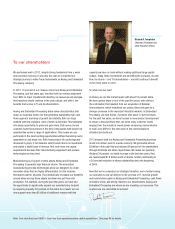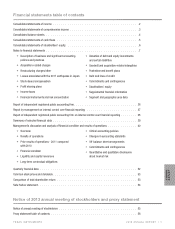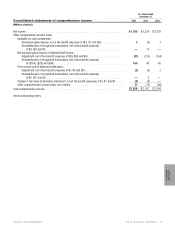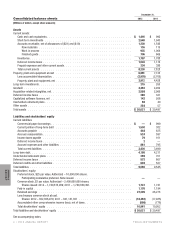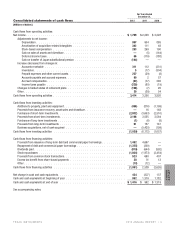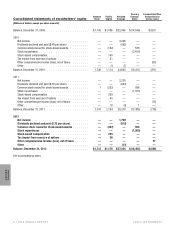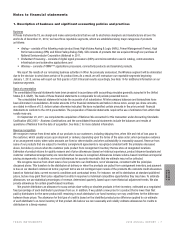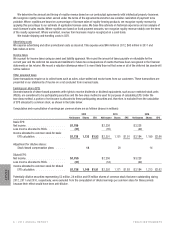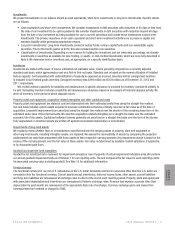Texas Instruments 2012 Annual Report Download - page 9
Download and view the complete annual report
Please find page 9 of the 2012 Texas Instruments annual report below. You can navigate through the pages in the report by either clicking on the pages listed below, or by using the keyword search tool below to find specific information within the annual report.
ANNUAL
REPORT
TEXAS INSTRUMENTS 2012 ANNUAL REPORT • 7
Notes to financial statements
1. Description of business and significant accounting policies and practices
Business
At Texas Instruments (TI), we design and make semiconductors that we sell to electronics designers and manufacturers all over the
world. As of December 31, 2012, we have three reportable segments, which are established along major categories of products
as follows:
• Analog – consists of the following major product lines: High Volume Analog & Logic (HVAL), Power Management (Power), High
Performance Analog (HPA) and Silicon Valley Analog (SVA). SVA consists of products that we acquired through our purchase of
National Semiconductor Corporation (National) in 2011.
• Embedded Processing – consists of digital signal processors (DSPs) and microcontrollers used in catalog, communications
infrastructure and automotive applications; and
• Wireless – consists of OMAP™ applications processors, connectivity products and baseband products.
We report the results of our remaining business activities in Other. As previously announced, the Wireless segment will be eliminated
due to the decision to wind down certain of its product lines. As a result, we will restructure our reportable segments beginning
January 1, 2013, and we will report our first quarter of 2013 financial results accordingly. See Note 16 for additional information on our
business segments.
Basis of presentation
The consolidated financial statements have been prepared in accordance with accounting principles generally accepted in the United
States (U.S. GAAP). The basis of these financial statements is comparable for all periods presented herein.
The consolidated financial statements include the accounts of all subsidiaries. All intercompany balances and transactions have
been eliminated in consolidation. All dollar amounts in the financial statements and tables in these notes, except per-share amounts,
are stated in millions of U.S. dollars unless otherwise indicated. We have reclassified certain amounts in the prior periods’ financial
statements to conform to the 2012 presentation. The preparation of financial statements requires the use of estimates from which final
results may vary.
On September 23, 2011, we completed the acquisition of National. We accounted for this transaction under Accounting Standards
Codification (ASC) 805 – Business Combinations, and the consolidated financial statements include the balances and results of
operations of National from the date of acquisition. See Note 2 for more detailed information.
Revenue recognition
We recognize revenue from direct sales of our products to our customers, including shipping fees, when title and risk of loss pass to
the customer, which usually occurs upon shipment or delivery, depending upon the terms of the sales order; when persuasive evidence
of an arrangement exists; when sales amounts are fixed or determinable; and when collectability is reasonably assured. Revenue from
sales of our products that are subject to inventory consignment agreements is recognized consistent with the principles discussed
above, but delivery occurs when the customer pulls product from consignment inventory that we store at designated locations.
Estimates of product returns for quality reasons and of price allowances (based on historical experience, product shipment analysis and
customer contractual arrangements) are recorded when revenue is recognized. Allowances include volume-based incentives and special
pricing arrangements. In addition, we record allowances for accounts receivable that we estimate may not be collected.
We recognize revenue from direct sales of our products to our distributors, net of allowances, consistent with the principles
discussed above. Title transfers to the distributors at delivery or when the products are pulled from consignment inventory, and payment
is due on our standard commercial terms; payment terms are not contingent upon resale of the products. We calculate credit allowances
based on historical data, current economic conditions and contractual terms. For instance, we sell to distributors at standard published
prices, but we may grant them price adjustment credits in response to individual competitive opportunities they may have. To estimate
allowances, we use statistical percentages of revenue, determined quarterly, based upon recent historical adjustment trends. We also
provide allowances for certain growth-based incentives.
We provide distributors an allowance to scrap certain slow-selling or obsolete products in their inventory, estimated as a negotiated
fixed percentage of each distributor’s purchases from us. In addition, if we publish a new price for a product that is lower than that
paid by distributors for the same product still remaining in each distributor’s on-hand inventory, we may credit them for the difference
between those prices. The allowance for this type of credit is based on the identified product price difference applied to our estimate
of each distributor’s on-hand inventory of that product. We believe we can reasonably and reliably estimate allowances for credits to
distributors in a timely manner.


